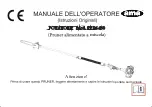
If the frame is used, it must be fixed on the floor with
four screws and the machine must be fixed on the fra-
me with four screws. Check the screws before swit-
ching the machine on.
ASSEMBLY AND SETTING-UP OF THE FENCE
-
Raise the handle upwards so that the claw of the guide
is open enough in order to place the fence on the ben-
ch top.
-
Now lay the fence on the bench and install the back
part (with the claw) and then place the front part over
the rail. With the handle at the front of the fence you
can adjust the clamping stress of the fence.
Lock the fence by pushing the handle downwards. If
the handle cannot be pushed through far enough, the
clamping stress is too high and you must turn the
handle a few turns looser. If the handle can be pushed
through far enough but the fence is not fastened or
loosens by vibration, the clamping stress is too low
and you must turn the handle a few turns tighter.
ASSEMBLY OF THE RIVING KNIFE AND OF THE TOP
GUARD
-
Turn the saw blade completely upwards.
-
Remove the bench inlay.
-
Assemble the riving knife on the set-up for this purpo-
se and use hereby the Allen screws and the filling
rings. Ensure that the riving knife falls properly into the
opening (= groove).
-
Now put the inlay back in the bench and fasten it.
-
Now assembly the top guard onto the riving knife and
use hereby the profiled nut and self-locking nut.
-
The riving knife should be adjusted that the radial dis-
tance between the blade and the riving knife is not
more than 8 mm. and not less then 3 mm. at any point.
Now lay a lath against the saw blade and the
riving knife and check whether it falls properly
into the extension of the saw blade. If this is not the case:
Loosen the fastening bolts and place or remove the filling
rings.
Fig. D.
-
Above the saw table the radial distance between the
riving knife and the toothed rim of the saw blade shall
not at any point exceed 5 mm at the depth of cut set.
-
The tip of the riving knife shall not be lower than 5 mm
from the tooth peak, as shown.
ASSEMBLY OF THE SAW BLADE
First remove the plug from the mains before the
saw blade is assembled or replaced.
-
Remove the inlay from the bench. Use a screwdriver
for this purpose.
-
Turn the saw axle completely upwards. Remove the
nut and the outside flange from the saw axle.
-
Now slide the saw blade over the saw axle and now
put the outside flange and the nut back. Tighten the
nut by hand.
-
Now use the 2 keys: one for the flange and one for the
nut and now clamp it.
-
Now put the inlay back in the bench and fasten it.
ADJUSTING THE Cross cut GUIDE
-
In order to adjust the cross cut fence the tension but-
ton must be loosened by one turn. In this way the sca-
le part can move freely.
-
Place a protractor (90°) against the contact side on
the one hand and the direction of sliding on the other
hand.
-
Now turn the scale part in such a way that both sides of
the protractor connect correctly.
-
Now turn the tension button back until it is fastened.
USE OF THE BEVEL SET-UP
By turning the height adjustment/mitre adjustment handle
at the side of the machine you can adjust the saw blade to
a maximum of 45°.
To adjust the saw blade:
-
loosen the mitre locking handle.
-
Press the mitre adjustment/height adjustment handle
and at the same time turn it around to place the saw
blade in the angle required.
-
Tighten the mitre locking handle again.
USE OF TABLE EXTENSIONS
By using the table extensions the table’s dimensions can
be extended to 660x865 mm maximum.
To mount a table extension:
-
remove the bolts at the side of the table.
-
position the table extension and hold it.
-
put the bolts back and tighten these.
5 mm max.
Ferm
5
56
Ferm






































